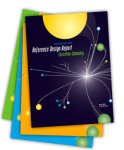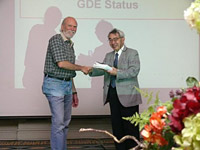Director's Corner
6 September 2007
 Barry Barish |
The Reference Design Report is now official
We released a draft version of the ILC Reference Design Report last February. Since that time, the accelerator section has undergone reviews by the ILCSC Machine Advisory Committee and by a special international panel for our cost estimates and future plans. In addition, we added some missing sections, improved figures, tables and text. We also worked jointly with the writers of the detector and physics volumes to create one Executive Summary that represents the entire report. The Detector Concept Report went through its own evolution. The DCR editors posted a draft for comment from the experimental community last spring and incorporated those suggestions. The final product is an attractive and readable four-volume report that we recently submitted to our two oversight committees, the Funding Agencies for Large Colliders (FALC) and the International Linear Collider Steering Committee (ILCSC). They both accepted the RDR, making it official. I am announcing that we are now making it available for download. We are also in the process of printing the report, and you can submit a request to receive the four-volume set when it is available later this autumn.
The RDR will now become our main resource document, during the period when we are carrying out a detailed engineering design. The four volumes cover all aspects of the ILC from the science to the machine and detector concepts, and include discussions of costs, siting and plans for the future.
The first volume in the RDR is a self-standing Executive Summary that is effectively an abbreviated version of the following three volumes. For many readers, it should serve as the technical reference for the ILC design, and further details can be found in the other volumes.
The physics volume contains a timely description of the ILC's science case, as we understand it today prior to seeing early results from the Large Hadron Collider. The physics, as presented, serves to guide the parameters of the designs for both the accelerator and detectors. The technical goals and requirements have been set by studies of what will be required to exploit these physics topics. The physics volume covers the major research topics pursued at the energy frontier, from Higgs' physics to supersymmetry to connections to cosmology. The complementary attributes of the LHC and ILC are also discussed to indicate how the future collider will build on the results of its predecessor.
The accelerator volume gives a complete technical description of the design of the ILC, including the detailed features, but excluding actual engineering designs. The design we present is robust, in the sense that we have optimised cost to performance by performing various trade studies. The design, technical details and costs have been extremely stable since presenting them last winter. The main features of the design are the two 10.5 kilometres superconducting radiofrequency linear accelerators that are located about 100 metres below the surface.
Finally, the detector volume describes four different concepts for the ILC detectors. It includes a chapter laying out the arguments for two detectors. It also explains how the design we present accommodates the two detectors through a “push-pull” system, whereby the detectors can alternatively be placed on the beam line. The ILC detectors aim to improve spatial and energy resolution significantly beyond the present state of the art. A vigorous R&D programme will be needed to achieve these goals for the actual detectors.
The RDR gives us a very strong technical basis for initiating the next steps toward a global ILC construction project. The accelerator design meets all the requirements set by the physics goals; the proposed designs and cost methodologies have been validated by international technical and cost review panels. We expect the costs to be contained in the next phase, and the RDR has identified many areas where we can potentially improve the cost to performance through value engineering, trade studies and possible scope reductions. Key issues for detectors have also been identified, and together we fully expect to progress systematically toward a strong construction proposal for our governments.
-- Barry Barish

